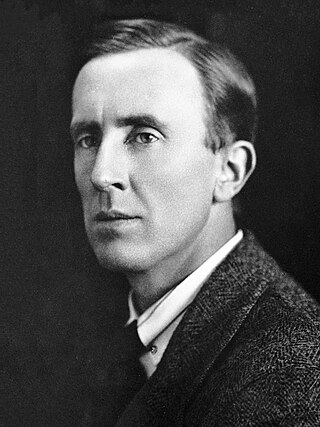Related Research Articles
Radagast the Brown is a fictional character in J. R. R. Tolkien's legendarium. A wizard and associate of Gandalf, he appears briefly in The Hobbit, The Lord of the Rings, The Silmarillion, and Unfinished Tales.

Thomas Alan Shippey is a British medievalist, a retired scholar of Middle and Old English literature as well as of modern fantasy and science fiction. He is considered one of the world's leading academic experts on the works of J. R. R. Tolkien about whom he has written several books and many scholarly papers. His book The Road to Middle-Earth has been called "the single best thing written on Tolkien".

The Round World Version is an alternative creation myth to the version of J.R.R. Tolkien's legendarium as it appears in The Silmarillion and The Lord of the Rings. In that version, the Earth was created flat and was changed to round as a cataclysmic event during the Second Age in order to prevent direct access by Men to Valinor, home of the immortals. In the Round World Version, the Earth is created spherical from the beginning.

The Mythopoeic Awards for literature and literary studies are given annually for outstanding works in the fields of myth, fantasy, and the scholarly study of these areas. Established by the Mythopoeic Society in 1971, the Mythopoeic Fantasy Award is given for "fiction in the spirit of the Inklings", and the Scholarship Award for non-fiction work. The award is a statuette of a seated lion, with a plaque on the base. It has drawn resemblance to, and is often called, the "Aslan".
Magic in Middle-earth is the use of supernatural power in J. R. R. Tolkien's fictional Middle-earth. Tolkien distinguishes ordinary magic from witchcraft, the latter always deceptive, stating that either type could be used for good or evil.
The cosmology of J. R. R. Tolkien's legendarium combines aspects of Christian theology and metaphysics with pre-modern cosmological concepts in the flat Earth paradigm, along with the modern spherical Earth view of the Solar System.

J. R. R. Tolkien: Author of the Century is a 2001 book of literary criticism written by Tom Shippey. It is about the work of the philologist and fantasy author J. R. R. Tolkien. In it, Shippey argues for the relevance of Tolkien today and attempts to firmly establish Tolkien's literary merits, based on analysis of The Hobbit, The Lord of the Rings, The Silmarillion, and Tolkien's shorter works.
J. R. R. Tolkien's bestselling fantasy novel The Lord of the Rings had an initial mixed literary reception. Despite some enthusiastic early reviews from supporters such as W. H. Auden, Iris Murdoch, and C. S. Lewis, literary hostility to Tolkien quickly became acute and continued until the start of the 21st century. From 1982, Tolkien scholars such as Tom Shippey and Verlyn Flieger began to roll back the hostility, defending Tolkien, rebutting the critics' attacks and analysing what they saw as good qualities in Tolkien's writing.

Saruman, also called Saruman the White, is a fictional character of J. R. R. Tolkien's fantasy novel The Lord of the Rings. He is leader of the Istari, wizards sent to Middle-earth in human form by the godlike Valar to challenge Sauron, the main antagonist of the novel, but eventually he desires Sauron's power for himself and tries to take over Middle-earth by force from his base at Isengard. His schemes feature prominently in the second volume, The Two Towers; he appears briefly at the end of the third volume, The Return of the King. His earlier history is summarised in the posthumously published The Silmarillion and Unfinished Tales.

The Road to Middle-Earth: How J. R. R. Tolkien Created a New Mythology is a scholarly study of the Middle-earth works of J. R. R. Tolkien written by Tom Shippey and first published in 1982. The book discusses Tolkien's philology, and then examines in turn the origins of The Hobbit, The Lord of the Rings, The Silmarillion, and his minor works. An appendix discusses Tolkien's many sources. Two further editions extended and updated the work, including a discussion of Peter Jackson's film version of The Lord of the Rings.
Christianity is a central theme in J. R. R. Tolkien's fictional works about Middle-earth, but the specifics are always kept hidden. This allows for the books' meaning to be personally interpreted by the reader, instead of the author detailing a strict, set meaning.
The theme of addiction to power in The Lord of the Rings is central, as the Ring, made by the Dark Lord Sauron to enable him to take over the whole of Middle-earth, progressively corrupts the mind of its owner to use the Ring for evil.

Richard Carroll West was an American librarian and one of the first Tolkien scholars. He is best known for his 1975 essay on the interlace structure of The Lord of the Rings, for which he won the 1976 Mythopoeic Scholarship Award for Inkling Studies.

Tolkien and the Great War: The Threshold of Middle-earth is a 2003 biography by John Garth of the philologist and fantasy author J. R. R. Tolkien's early life, focusing on his formative military experiences during the First World War.
J. R. R. Tolkien, the author of the bestselling fantasy The Lord of the Rings, was largely rejected by the literary establishment during his lifetime, but has since been accepted into the literary canon, if not as a modernist then certainly as a modern writer responding to his times. He fought in the First World War, and saw the rural England that he loved built over and industrialised. His Middle-earth fantasy writings, consisting largely of a legendarium which was not published until after his death, embodied his realism about the century's traumatic events, and his Christian hope.

Scholars have identified numerous themes in J. R. R. Tolkien's Middle-earth writings, among them paganism. Despite Tolkien's assertion that The Lord of the Rings was a fundamentally Christian work, paganism appears in that book and elsewhere in his fictional world of Middle-earth in multiple ways. These include a pantheon of god-like beings, the Valar, who function like the Norse gods, the Æsir; the person of the wizard Gandalf, who Tolkien stated in a letter is an "Odinic wanderer"; Elbereth, the Elves' "Queen of the Stars", associated with Venus; animism, the way that the natural world seems to be alive; and a Beowulf-like "northern courage" which is determined to press on, no matter how bleak the outlook.

J. R. R. Tolkien took part in the First World War, known then as the Great War, and began his fantasy Middle-earth writings at that time. The Fall of Gondolin was the first prose work that he created, and it contains detailed descriptions of battle and streetfighting. He continued the dark tone in much of his legendarium, as seen in The Silmarillion. The Lord of the Rings, too, has been described as a war book.

Tolkien's Art: 'A Mythology for England' is a 1979 book of Tolkien scholarship by Jane Chance, writing then as Jane Chance Nitzsche. The book looks in turn at Tolkien's essays "On Fairy-Stories" and "Beowulf: The Monsters and the Critics"; The Hobbit; the fairy-stories "Leaf by Niggle" and "Smith of Wootton Major"; the minor works "Lay of Autrou and Itroun", "The Homecoming of Beorhtnoth", "Imram", and Farmer Giles of Ham; The Lord of the Rings; and very briefly in the concluding section, The Silmarillion. In 2001, a second edition extended all the chapters but still treated The Silmarillion, that Tolkien worked on throughout his life, as a sort of coda.
J. R. R. Tolkien derived the characters, stories, places, and languages of Middle-earth from many sources. Shakespeare's influence on Tolkien was substantial, despite Tolkien's professed dislike of the playwright. Tolkien disapproved in particular of Shakespeare's devaluation of elves, and was deeply disappointed by the prosaic explanation of how Birnam Wood came to Dunsinane Hill in Macbeth. Tolkien was influenced especially by Macbeth and A Midsummer Night's Dream, and he used King Lear for "issues of kingship, madness, and succession". He arguably drew on several other plays, including The Merchant of Venice, Henry IV, Part 1, and Love's Labour's Lost, as well as Shakespeare's poetry, for numerous effects in his Middle-earth writings. The Tolkien scholar Tom Shippey suggests that Tolkien may even have felt a kind of fellow-feeling with Shakespeare, as both men were rooted in the county of Warwickshire.
The economy of Middle-earth is J. R. R. Tolkien's treatment of economics in his fantasy world of Middle-earth. Scholars such as Steven Kelly have commented on the clash of economic patterns embodied in Tolkien's writings, giving as instances the broadly 19th century agrarian but capitalistic economy of the Shire, set against the older world of feudal Gondor. Others have remarked on the culture of gifting and exchange, which reflects that of early Germanic cultures as described in works like Beowulf. A different clash of cultures is addressed by Patrick Curry, who contrasts the pre-modern world of the free peoples of Middle-earth with the industrialising and in his view "soulless" economies of the wizard Saruman and the dark lord Sauron, based on machinery, fire, and labour.
References
- 1 2 3 Curry, Patrick. "Background". Patrick Curry. Retrieved 7 November 2021.
- ↑ "The Books". Brook Green Books. Retrieved 7 November 2021.
- ↑ Wood, Juliette (1998). "[Review:] Defending Middle-Earth. Tolkien: Myth and Modernity". Gale Academic Onefile. Retrieved 7 November 2021.
- ↑ Caldecott, Stratford (1998). "Defending Middle-Earth: Tolkien: Myth and Modernity, by Patrick Curry". The Chesterton Review . Philosophy Documentation Center. 24 (1): 110–112. doi:10.5840/chesterton1998241/212. ISSN 0317-0500.
- ↑ Schwartz, Adam (1999). "[Review:] Defending Middle-Earth: Tolkien: Myth and Modernity by Patrick Curry". VII. 16: 112–115. JSTOR 45296757.
- ↑ Martin, Bernice (29 May 2020). "Awesome". The Times Literary Supplement . Retrieved 7 November 2021.
- ↑ Shippey, Tom (2014). "[Review:] Deep Roots in a Time of Frost (2014) by Patrick Curry". Journal of Tolkien Research . 1 (1). Article 7.
